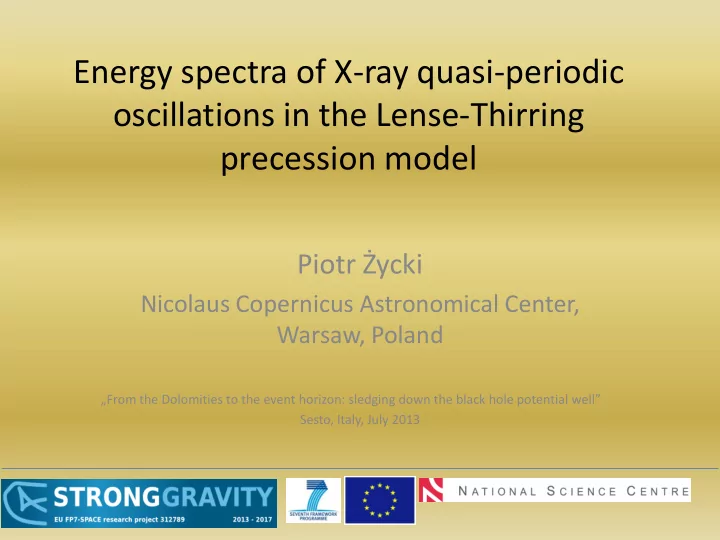

Energy spectra of X-ray quasi-periodic oscillations in the Lense-Thirring precession model Piotr Życki Nicolaus Copernicus Astronomical Center, Warsaw, Poland „From the Dolomities to the event horizon: sledging down the black hole potential well” Sesto, Italy, July 2013
X-ray QPO Low- f QPO
Observed energy spectra of QPO Sobolewska & Ż ycki 2006 Disk emission is not present in the QPO spectra. When time averaged spectra are soft, the QPO spectra are harder than the time averaged spectra.
Observed energy spectra of QPO Hard spectral state Intermediate state Sobolewska & Ż ycki 2006 When the time averaged spectra are hard, the QPO spectra are softer than the time averaged spectra
Generic Comptonization models (Thermal) Comptonization is described by two main parameters: heating rate and cooling rate of the plasma. Spectral slope determined by the ratio of the two quantities. Variability (broad-band or QPO) may be driven by variations of l h and/or l s . In the specific situation of multi-phas accretion flows (soft photons from reprocessing) one can also imagine variations of the geometry of the flow, leading to variations of the viewing geometry (e.g. viewing angle), heating-to-cooling ratio and/or reflection amplitude.
Modulation of heating rate Spectral variability folded r.m.s./mean Energy spectra with QPO period variability QPO energy spectrum is harder than the time averaged spectrum Ż ycki & Sobolewska 2005
Modulation of cooling rate Spectral variability folded r.m.s./mean Energy spectra with QPO period variability QPO energy spectrum is softer than the time averaged spectrum
Modulation of the covering factor of the cold matter Fe K α line present in the QPO spectrum
Lense-Thirring precession model for low- f QPO Formulated by Stella & Vietri (1998) Recent hydrodynamical simulations suggest that the hot flow behaves (precesses) like a solid body. Inner radius of the flow is determined by properties of the bending waves. It is approximately independent of the spin of the black hole. As a result the maximum precession frequency does not depend on the spin) (C. Done, A. Ingram, C. Fragile)
Geometry Two geometrical scenarios: 1. precession axis perp. to the outer disk 2. Precession axis inclined to the outer disk (based on Bardeen- Peterson effect)
Geometry
geometrically thick torus; to be compared with the blue curve coplanar config. prec. axis perp. to the outer disk prec. axis inclined to the outer disk
Results Precesion scenario 1 (precession axis perpendicular to the outer disk axis)
Precesion scenario 2 (precession axis inclined to the outer disk axis) precession axis towards the observer
Precesion scenario 2 (precession axis inclined to the outer disk axis) precession axis away from the observer
Variations of the iron K α line Ingram & Done 2012
Recommend
More recommend